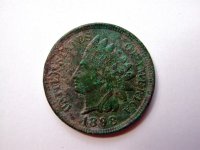This advice appeared in the 1962 edition of Seaby's Standard Catalogue, and it still appears in the same book today, although it is now published by Spink.
If You Have To Ask - Definitely Do Not Clean Them!
It's true that if you had to ask about cleaning your coins, how to, or whether to, then the best thing for you to do is nothing. Don't clean them. You will almost certainly not improve them, and you are much more likely to spoil them.
If You Really Must - How To Clean Coins
First - Cleaning Gold Coins.
Because gold is a noble metal, it is unlikely to become discoloured. Wash carefully in warm, even boiling, soapy water (detergent is also OK). You may even brush it gently with a soft brush. Be careful, if there is any grit present it will make minute scratches on the surface.
Cleaning Silver Coins.
Silver acquires a tone through tarnishing. A pleasant, even tone can enhance the appearance and desirability of an old silver coin. Some toning has rich blue, green, indigo, and violet "oil effects", toning like this will be appreciated by most connoisseurs. Do not clean any silver coin with this type of toning.
If a silver coin is so dark brown or black that its design can hardly be seen, then it may, be worth dipping, usually in a proprietary solution, such as Goddard's Silver Dip. If in any doubt, don't!
Whatever you do, do not use any abrasive paste or cloth.
Warm soapy water may also be used.
Even if silver coins are carefully cleaned, they end up looking artificially bright and silvery. Many collectors will not buy a silver coins which looks as though it has been cleaned.
Cleaning Copper and Bronze Coins
Copper and bronze coins usually look awful when they have been cleaned. They are more easily ruined than silver or gold coins. Once again, the best advice is do not clean copper or bronze coins.
Leave It To The Experts
Usually, the people who ask about cleaning coins are those who have recently acquired them. They may have found them in old drawer, or been left them in the estate of a relative or friend. Because they find them difficult to read, they assume that the coins need cleaning. It's much more likely that their glasses need cleaning.
Metal detectorists usually learn which coins may benefit from cleaning, and how to do it. Some will often use an ultrasonic tank. This is not a magic device, it merely uses ultrasound waves to agitate the liquid in which the coins are immersed. This will often be soapy water, and nothing more. Sound waves are gentler than a soft brush.
Many people now own miniature domestic ultrasonic tanks, sold for cleaning jewellery. Before you are tempted to clean your coins in such a tank, remember the advice repeatedly give above, if you are unsure - do not clean coins.
Cleaning Coins Spoils the Toning
It is easy to spoil a pleasing tone, which may have taken centuries to be acquired. Copper and bronze coins will almost always end up looking a brassy unpleasant colour after cleaning. Even gold coins can sometimes be ruined by removing a rich tone which has built up over a long period of time.
Avoid Abrasives
One of the easiest way to spoil coins is to scratch or abrade their surfaces by using an abrasive. Most cleaning pastes contain abrasive. Any sort of rubbing action should also be avoided, whether using the fingers or a cloth, especially polishing cloths which are impregnated with any kind of cleaning material, and which are usually sold for polishing.
Drying Coins After Cleaning
If you simply have to clean coins after reading this, be careful when it comes to drying them. Any rubbing action will scratch them. Dabbing or patting dry with a clean towel will be the best.
How Harmful Is Cleaning Coins?
This from a dealer in coins . . .
Over 90% of the coins brought in to us by non-collectors are junk. Even so, junk has a value, and the value will be greater if the coins have not been cleaned. Assume someone brought us a box of 100 mixed coins which we were prepared to pay £10 for, if they had been cleaned we would be less interested, and may only pay £5, so cleaning would have halved the potential value for the owner.
Let's assume you found a mint condition1869 penny with its original mint lustre. For this great rarity, we would be happy to pay close to £1,000. If you cleaned the same penny with "Brasso", we would be reluctant to pay more than £100 for it. You would have destroyed about 90% of the coin's value by cleaning it.



 ) If anyone has tried this I would be curious as to how it turned out .
) If anyone has tried this I would be curious as to how it turned out .